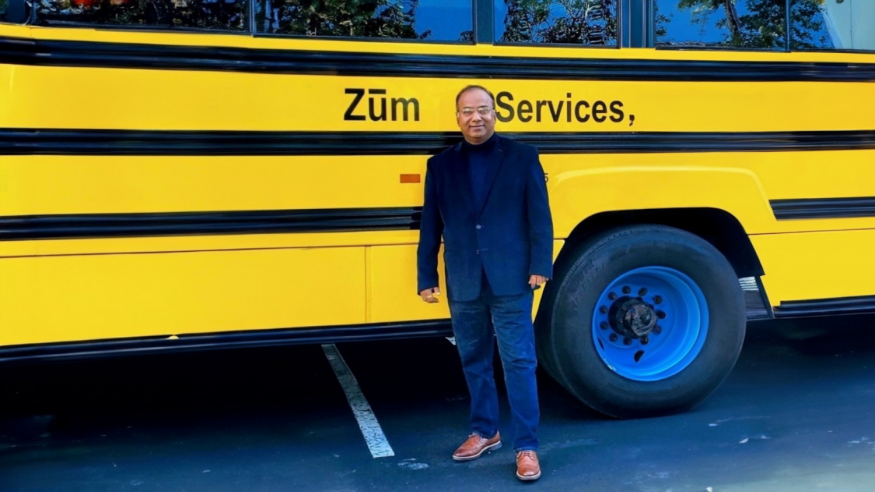
Dr. Pallav Prakash's life is like a tapestry draped over a building. His unwavering quest to improve himself and become an expert in his field has made him wise. His academic self-assurance is a testament to his dedication and skill in his current work on Electric Vehicle (EV) school bus deployment. His decades of wisdom start from his fearless tenure as an Indian Navy submarine officer and continue today as a focused effort to make school transportation in the US clean and healthy for all.
Dr. Pallav has enjoyed a close relationship with EV technology since the early days of his career. "I have been very comfortable with this technology, even under tough conditions underwater," he discloses, confidence saturating his words, "and I have fallen in love with its potential use on land for mobility. Especially in the service of school going children."
Electric vehicle's potential is as vast as the ocean Pallav traversed during his early years. As a submarine officer, he worked on undersea vehicles powered and operated by batteries.
"Electric vehicles have always been used for various purposes. During war. For space exploration," he explains seriously, "compared to that, adapting it to and deploying the technology on land is far easier. All my life, I have worked on battery systems. The types have changed, but I am able to adapt."
Society's needs have changed alongside technological advancement. We need cleaner energy and a better, more reliable power grid. And our society's collective teamwork has found a way to allow EVs to drive us towards a solution in a remarkably simple form- the archetypical yellow school bus!
Think about how school buses are used. They pick kids up in the morning and drop them off at the end of the school day. What do they do in between, or during holidays? Nothing much. Sitting idle, bored. If school buses could talk, they would probably be asking for something to do, even if just to pass the time.
So why not harvest their leftover electrical energy and connect them to our electric grids?
These beloved yellow school buses could act as energy stores and supply energy when demand is at its peak. A battery built into the bus would store energy, and when the demand for energy soars, the buses would send energy back into the electric grid. This is accomplished using a technology called 'Vehicle-to-Grid', also known as V2G. V2G, as the name suggests, connects a vehicle to the electric grid, an innovative deployment of technology that serves the ultimate goal of a cleaner environment for a healthier humanity.
The future of power lies in a vehicle that transports the future of humanity- children!
As he passionately explains the usefulness of this technological innovation, Pallav talks about his motivation to be a strategist and leader in sustainable technology: "By deploying EV, not only would I be supporting future generations, but I would also be furthering the usage of cleaner tech to support society in moments of need." He also wants to bring the best qualities of the old into newer operations. His goal is to not only provide a healthier life for school kids but also to make our planet greener and cleaner.
"In life", he says, "you never know how your future story will be woven. I didn't know that my life as a young officer in the navy would contribute to my current work deploying EV school buses."
His journey is certainly as interesting as the technology he is deploying for a cleaner future. Pallav cites his life journey as one that accumulated various experiences that help him even today.
He recalls his extensive educational background with the assurance that only academic excellence can provide. "My background in physical sciences has given me a solid foundation. On this, I built pillars that supported me further. My post-grad in economics supplemented my business knowledge, as did my degree in management studies. My doctorate in 'innovation and strategy' taught me how to work with technological innovations."
His wisdom truly shines through the two decades of experience under his belt. He says life is like a woven cloth. "Once you sew these different pieces together, it turns into a very harmonious journey that eventually led me to reach this point. It has been more interesting to ponder than can be expressed in words."
Indeed, one's life journey can never be predicted. But everything you do adds up to create something beautiful for the future. Pallav Prakash's life threads have been knitted together into a tapestry that depicts a journey towards a brighter and cleaner tomorrow.
[Dr. Pallav Prakash currently works as a Program Manager at Zum Services Inc. and leads the company's initiative on Net Zero Transition. He is also a judge at Stanford University on the subject of "Value creation for the Real Economy" as well as a mentor to the students at the University of California at Berkeley. He is an alumnus of Johns Hopkins University and Indian Institute of Management, Lucknow, India]
© 2025 ScienceTimes.com All rights reserved. Do not reproduce without permission. The window to the world of Science Times.











